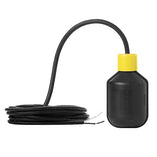Call: (936)-681-8198
(936)-681-8198

Key Features Specs Warranty The ATER Control Float Switch is reliable, and designed to manage water levels in various septic applications. It ...
View full detailsKey Features Specs Warranty ATER Pumps Float Switch Pump Duty Normally Open Narrow Angle Mechanical Float w/20' Cord 115/230 VAC 50/60 Hz. I...
View full detailsKey Features Specs Warranty ATER Pumps Float Switch Pump Duty Normally Open Mechanical Float Narrow Angle w/50' Cord 115/230 VAC 50/60 Hz. I...
View full detailsKey Features Specs Warranty ATER Pumps Float Switch Pump Duty Normally Open Mechanical Float Narrow Angle w/30' Cord 115/230 VAC 50/60 Hz. I...
View full detailsKey Features Specs Warranty ATER Pumps Float Switch Pump Duty Normally Open Narrow Angle Mechanical Float w/15' Cord 115/230 VAC 50/60 Hz. I...
View full detailsAlarm-Duty float switches used in residential septic systems are typically rated for around 5 amps and typically controls power in-directly through a relay in the panel to your effluent or solids pump (or controls something low-amperage such as your alarm circuit) these typically come in two types:
Normally-Open float switches default to the "open" state in which power cannot flow freely through the float switch. So until the water level in the septic tank rises to lift it up, your high-water alarm will remain off.
Normally-Closed floats default to the "closed" state in which power can flow freely through the float switch. Typically this means that when the float has been raised up by high effluent level, the control circuit will lost power.
Typically, alarm-duty floats will be narrow-angle, meaning that the angle required to engage and disengage the alarm-duty float will be approximately 15 degrees, vs something like 90 degrees with wide-angle floats.
$100.00 away from free shipping!
